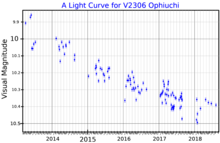Wolf 1061
| Observation data Epoch J2000 Equinox J2000 | |
|---|---|
| Constellation | Ophiuchus |
| Right ascension | 16h 30m 18.0584s[1] |
| Declination | −12° 39′ 45.325″[1] |
| Apparent magnitude (V) | 10.07[2] (10.05 - 10.10)[3] |
| Characteristics | |
| Spectral type | M3.5V[4] |
| U−B color index | +1.20[5] |
| B−V color index | +1.57[2] |
| Variable type | BY Draconis[3] |
| Absolute magnitude (MV) | 11.87[4] |
| Details | |
dex | |
| Rotation | 95 d[4] |
LHS 419, Vys 164 | |
| Database references | |
| SIMBAD | data |
Wolf 1061 (also known as
The star

Wolf 1061 was first cataloged in 1919 by German astronomer Max Wolf when he published a list of dim stars that had high proper motions. Wolf 1061's name originates from this list.[11] A seven years study found no evidence of photometric transits and confirms the radial velocity signals are not due to stellar activity. The habitable zone estimate for the system lies between approximately 0.1 and 0.2 AU from the star.
Planetary system

In December 2015, a team of astronomers from the
All three planets have masses low enough that they are likely to be
One of the planets,
In March 2017, another team of astronomers re-analyzed the system using the HARPS spectrograph. They found planets b and c to be quite similar to their originally reported parameters, but found that planet d was more massive and in a larger, more eccentric orbit. The team was also able to find updated parameters for the host star. Their results showed that Wolf 1061 c is slightly smaller, yet closer to the inner edge of the habitable zone.[4]
| Companion (in order from star) |
Mass | Semimajor axis (AU) |
Orbital period (days) |
Eccentricity | Inclination | Radius |
|---|---|---|---|---|---|---|
b
|
≥1.91 ± 0.25 M🜨 | 0.0375 ± 0.0012 | 4.8869 ± 0.0005 | 0.15 +0.13 −0.10 |
— | 1.2 (estimated) R🜨 |
c
|
≥3.41 +0.43 −0.41 M🜨 |
0.0890 ± 0.003 | 17.8719 ± 0.0059 | 0.11 +0.10 −0.07 |
— | 1.45 (estimated) R🜨 |
d
|
≥7.7 +1.12 −1.06 M🜨 |
0.470 ± 0.016 | 217.21 +0.55 −0.52 |
0.55 +0.08 −0.09 |
— | 2.2 (estimated) R🜨 |
See also
References
- ^ S2CID 1828208.
- ^ S2CID 30738573, 200.
- ^ Bibcode:2009yCat....102025S.
- ^ S2CID 119418595.
- Bibcode:1986EgUBV........0M.
- S2CID 51814894.
- .
- ^ S2CID 235435757. 40.
- ^ S2CID 52320394.
- ^ "ASAS-SN Variable Stars Database". ASAS-SN Variable Stars Database. ASAS-SN. Retrieved 6 January 2022.
- Bibcode:1919VeHei...7..195W.
- ^ "Astronomers discover closest potentially habitable planet: Wolf 1061c". ScienceAlert.com. 17 December 2015. Retrieved 17 December 2015.
- S2CID 9719725.
- ^ Stuart Gary (17 December 2015). "Potentially habitable super-Earth discovered orbiting star 14 light years from Earth". ABC News (Australia).


